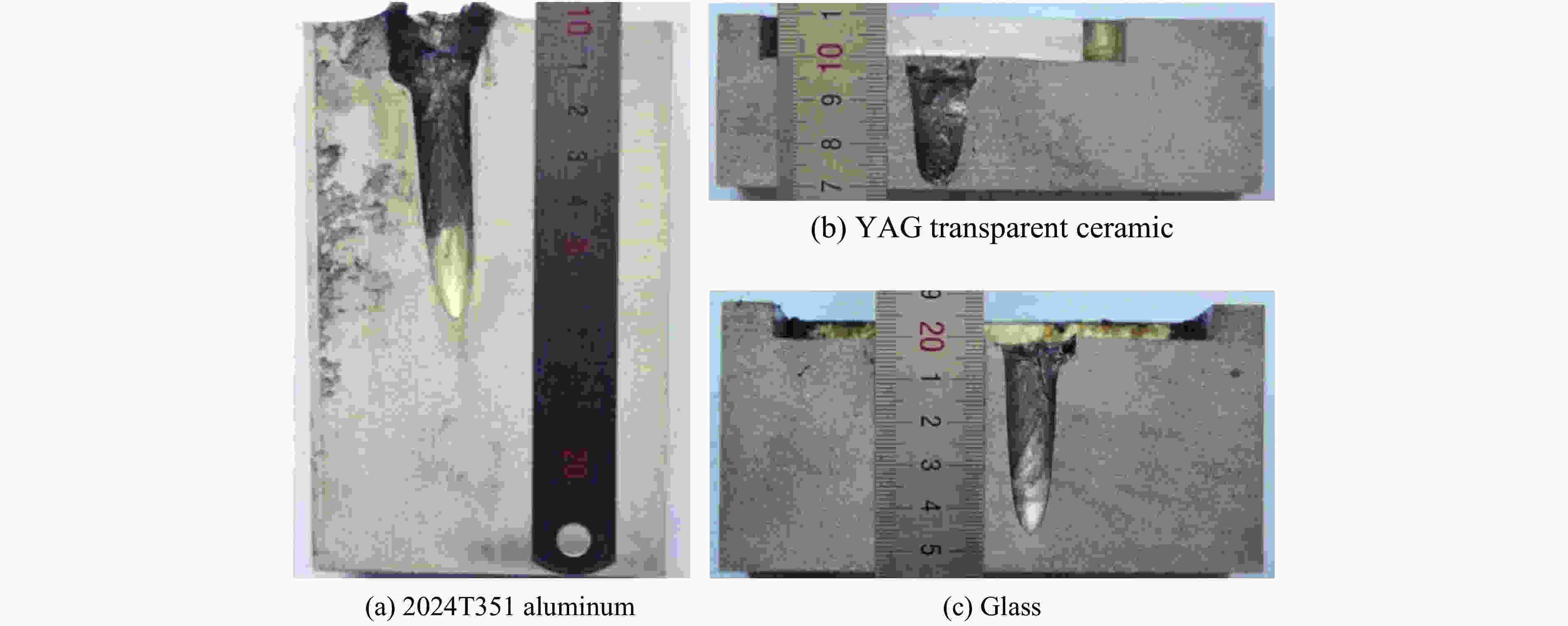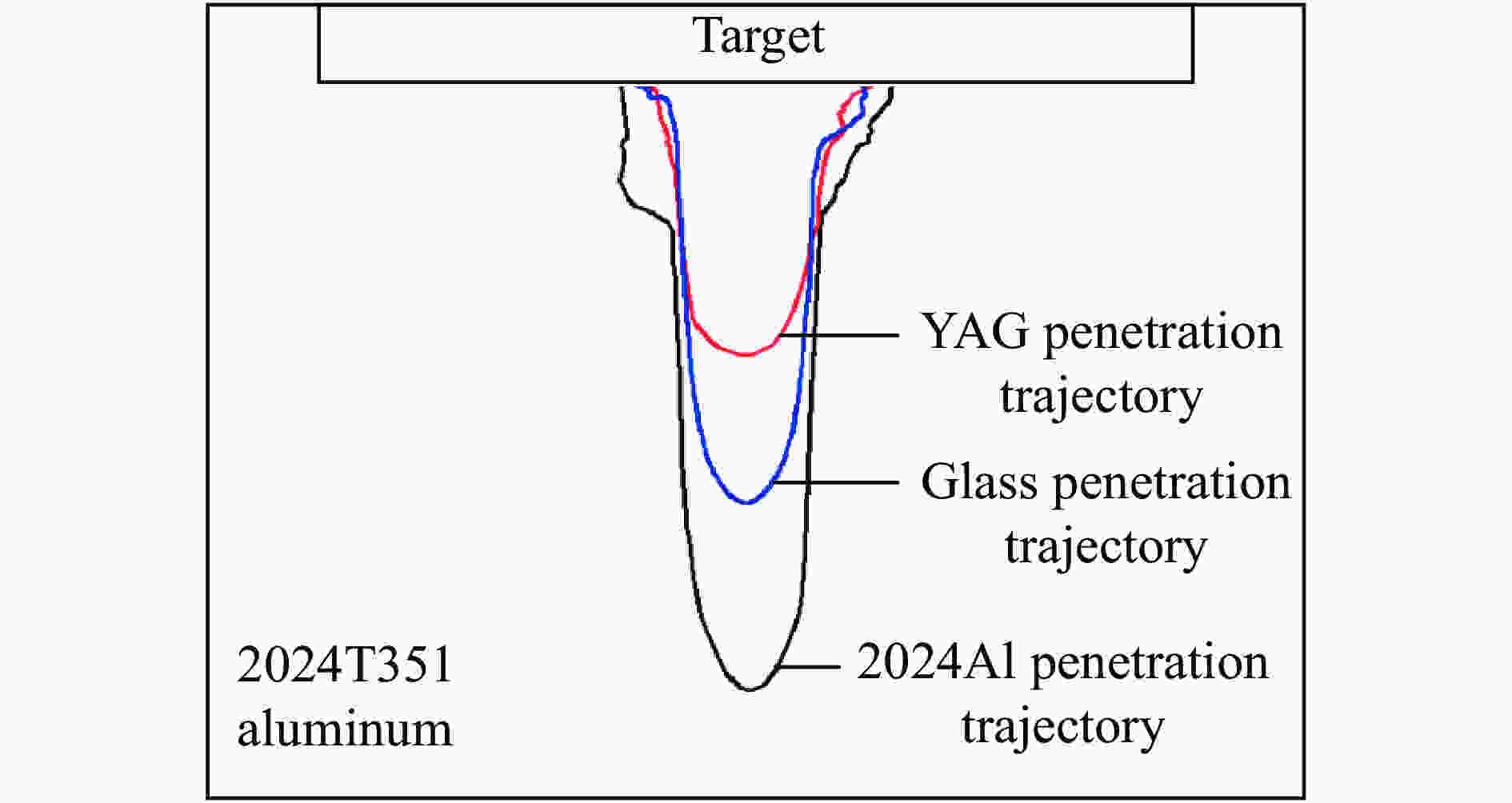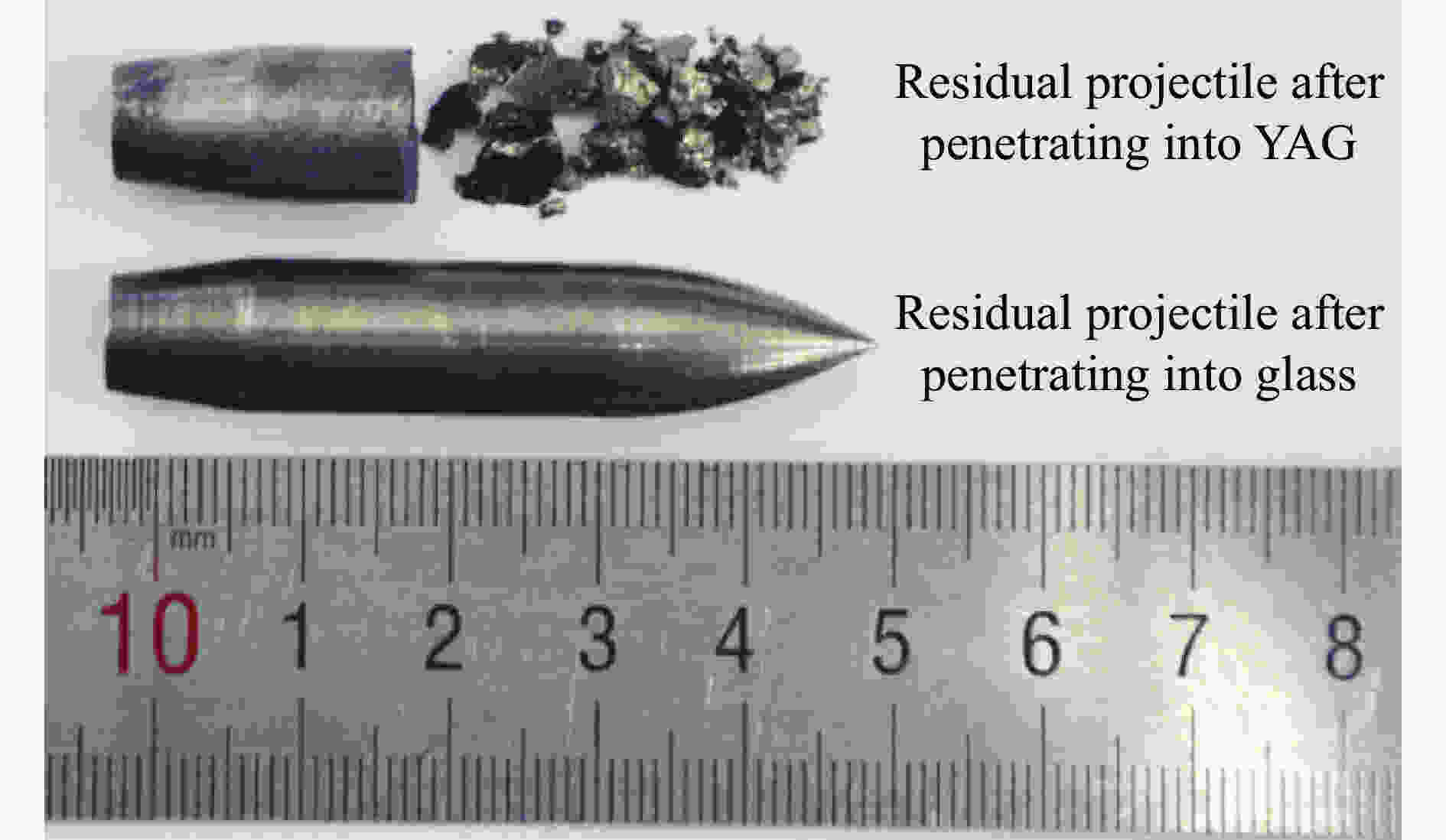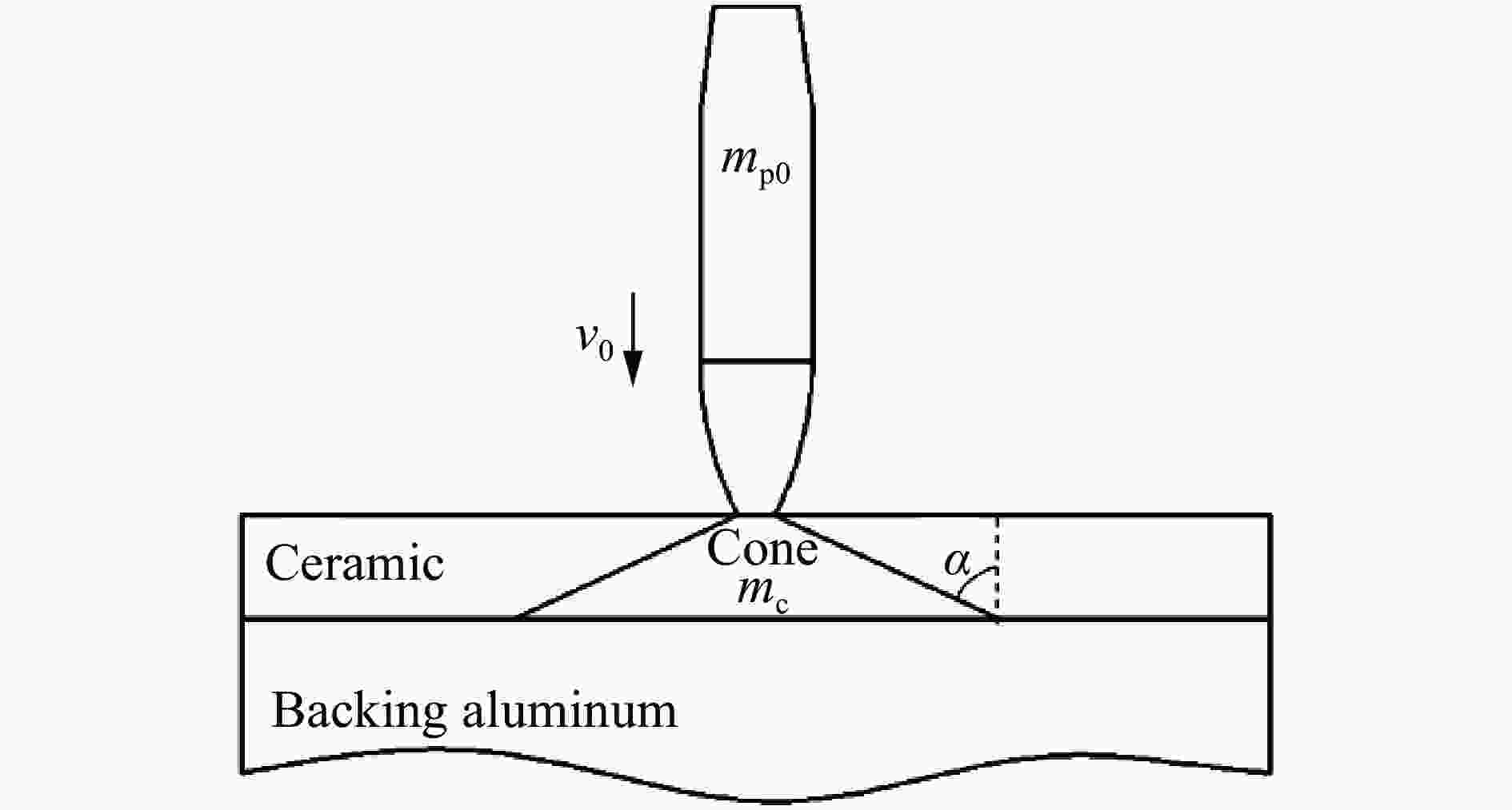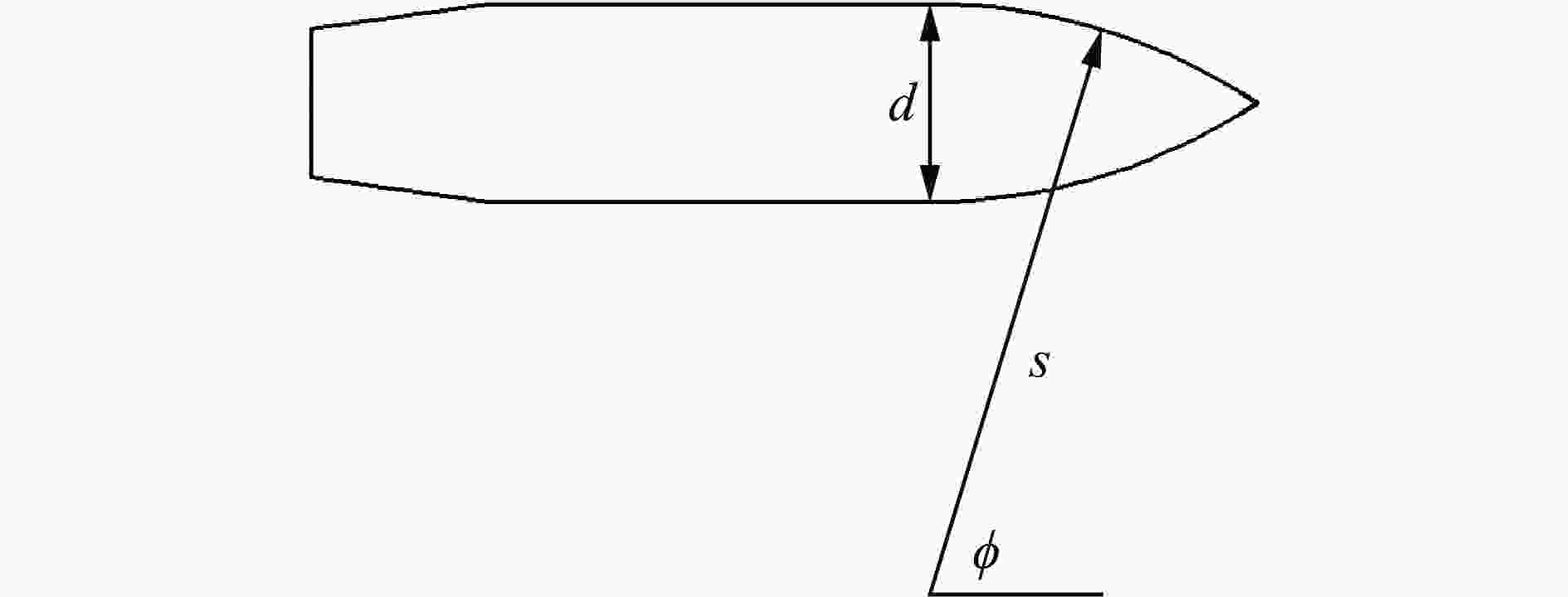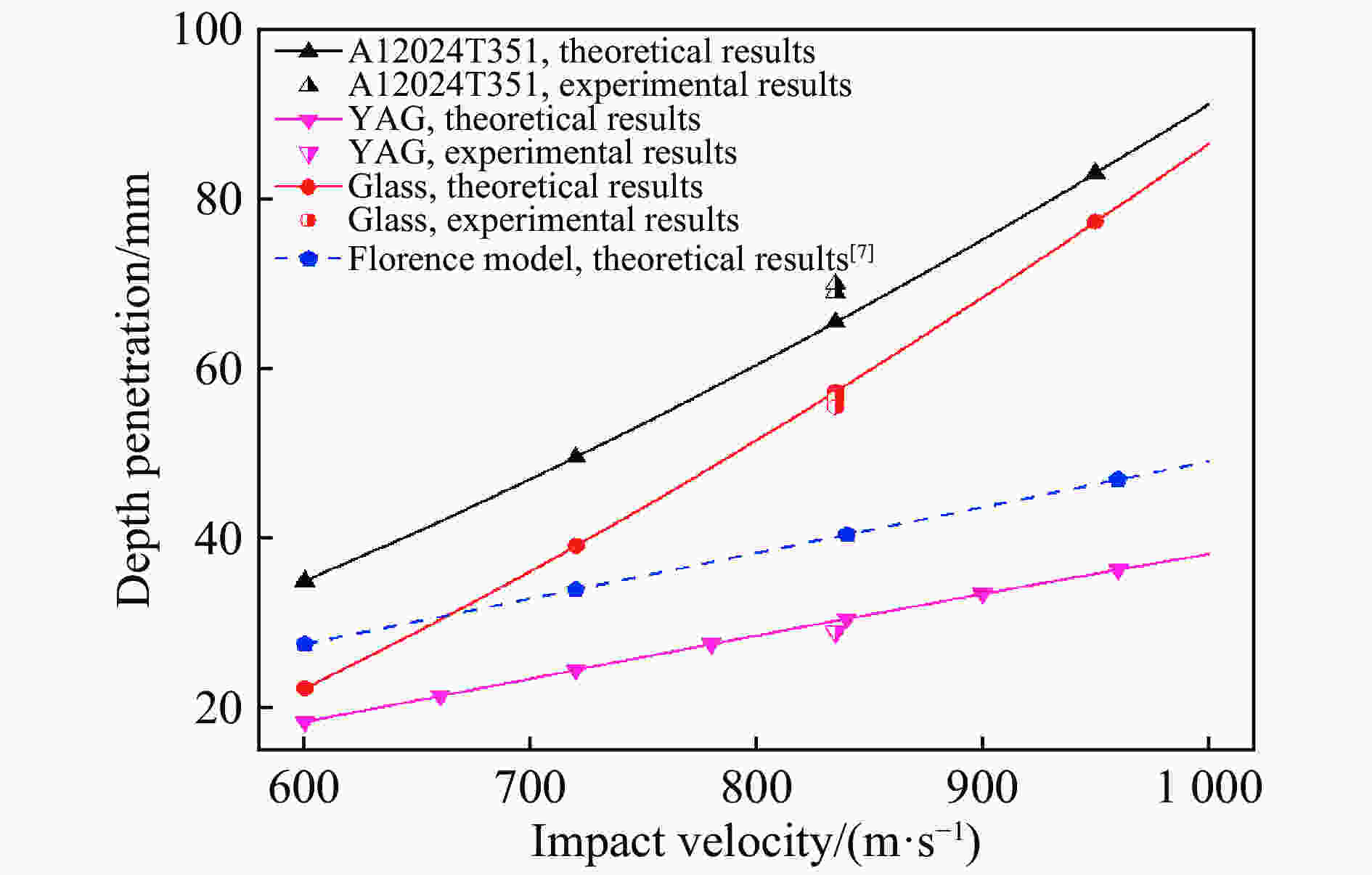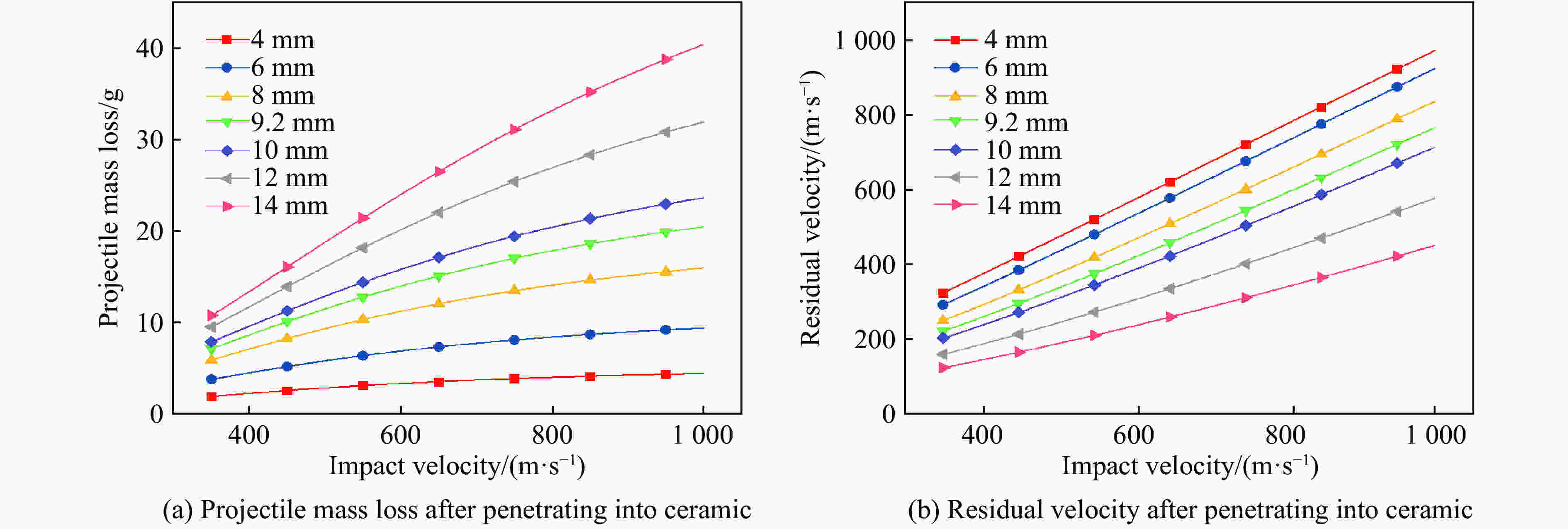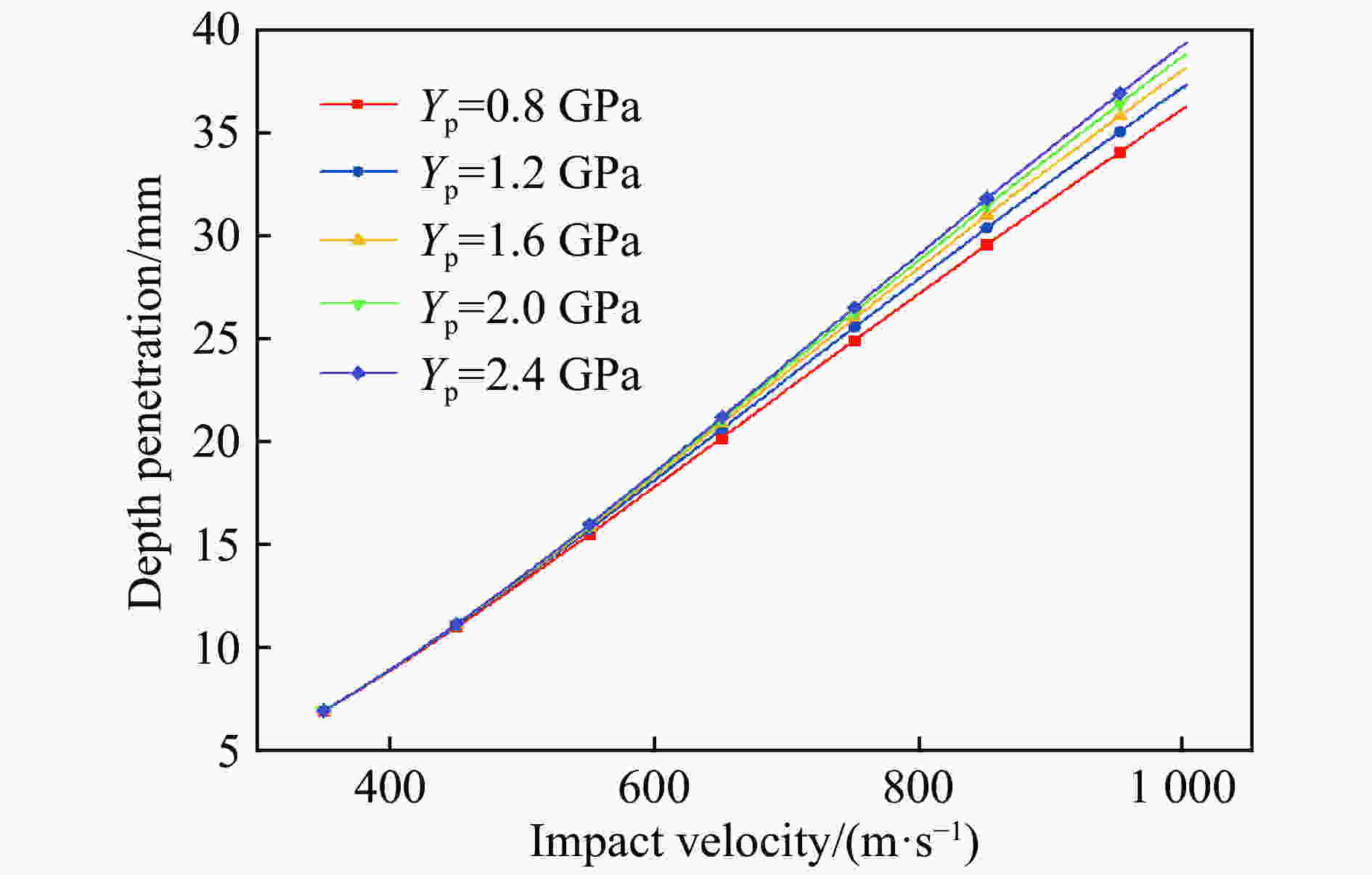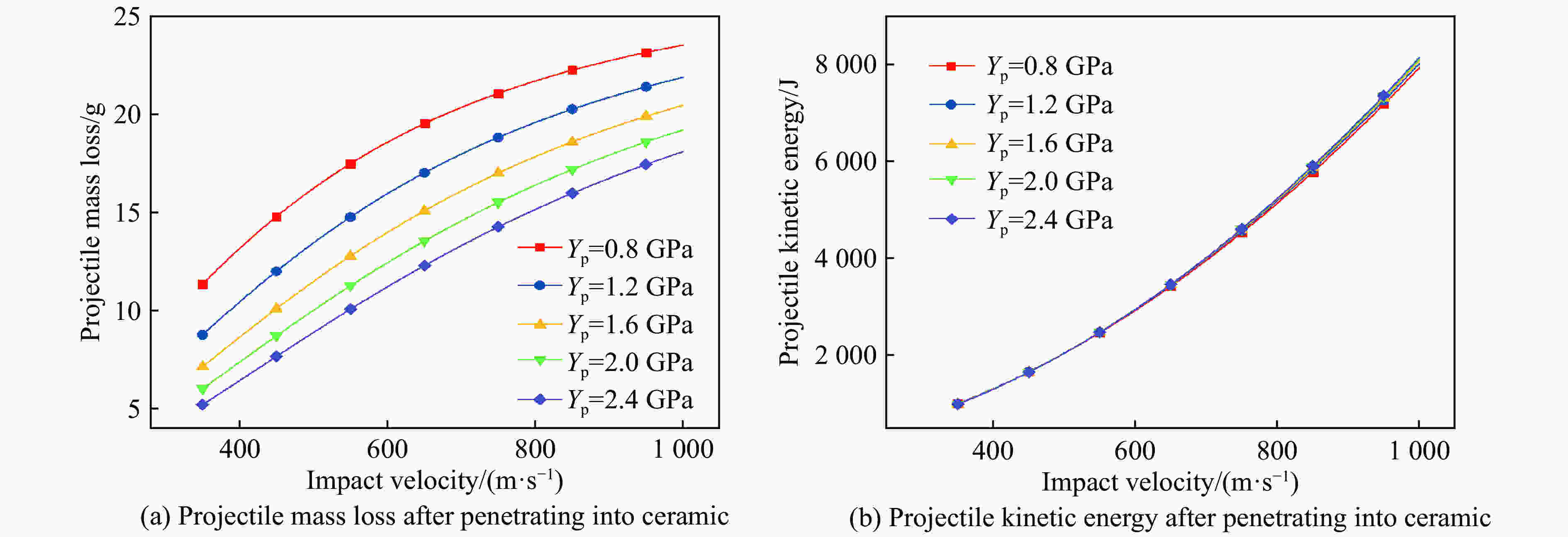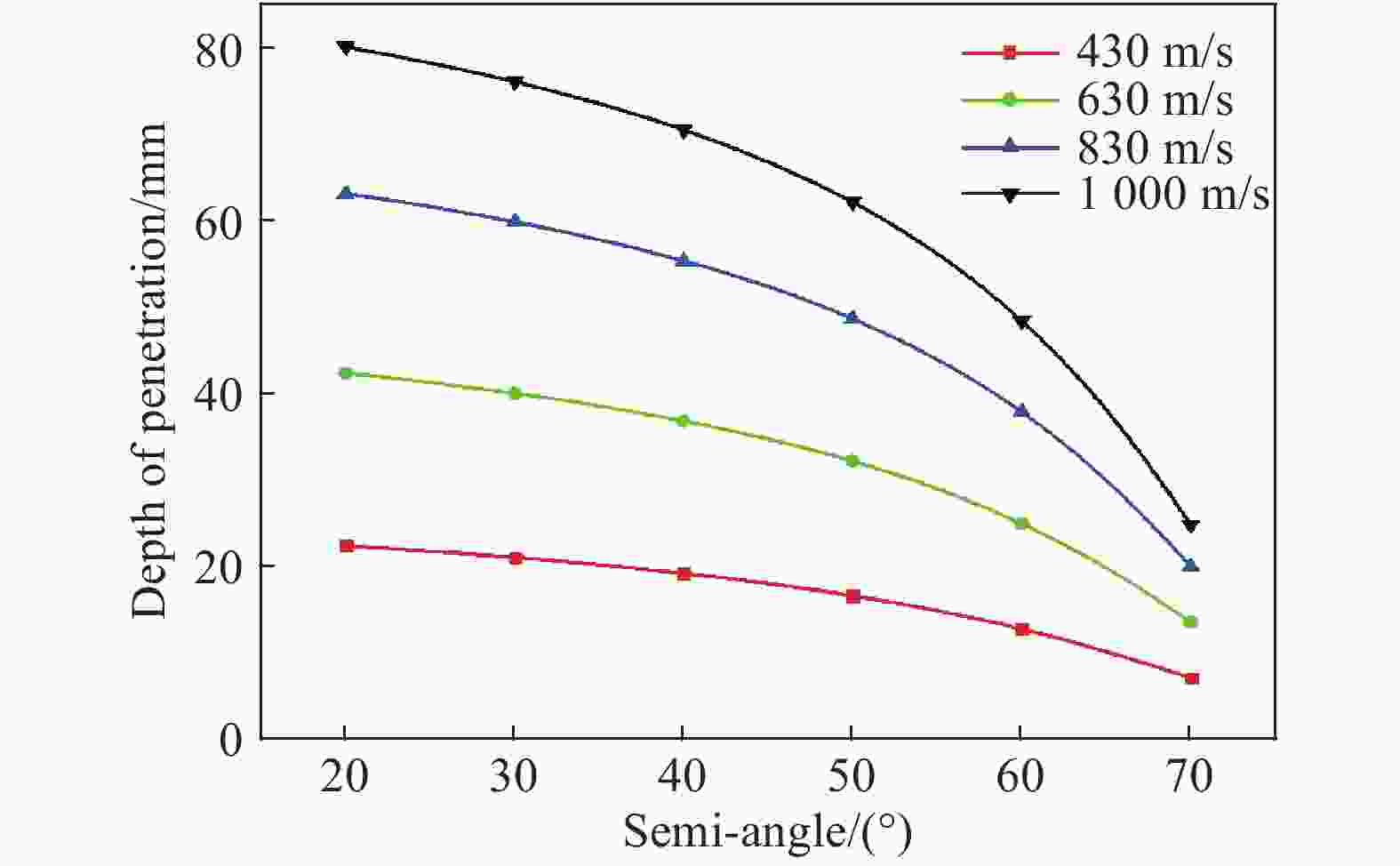Residual penetration depth of a projectile into YAG transparent ceramic/glass
-
摘要: 为了研究钇铝石榴石(yttrium aluminum garnet, YAG)透明陶瓷及玻璃材料的抗弹性能和冲击破坏机制,开展了12.7 mm穿甲燃烧弹侵彻YAG透明陶瓷/玻璃的剩余侵彻深度实验研究。基于变形侵彻和刚性侵彻机制建立理论模型分析子弹撞击YAG透明陶瓷和玻璃的作用过程,并利用空腔膨胀模型确定了剩余弹体对2024T351航空铝的剩余侵彻深度。实验结果表明:YAG透明陶瓷对子弹有较强的破碎作用,其防护能力显著高于玻璃材料。理论模型计算得到的剩余弹体质量和侵彻深度结果与实验结果吻合较好,可见本文建立的理论模型可用于评估不同面板材料的抗弹性能。Abstract: In order to study the projectile-proof performance and impact damage mechanism of yttrium aluminum garnet (YAG) transparent ceramic and glass, the residual penetration depths of 12.7 mm armor-piercing projectiles penetrating into YAG transparent ceramic/glass were experimentally studied. A theoretical model was established based on the mechanism of deformation penetration and rigid penetration to analyze the processes of the projectiles impacting the YAG transparent ceramic and glass, and the cavity penetration model was used to determine the residual penetration depth of the projectile into the 2024T351 aluminum. The experimental results show that the YAG transparent ceramic has a strong crushing effect on projectiles, and its projectile-proof ability is significantly better than that of the silicate glass. The mass of the residual projectile and the penetration depth calculated by the theoretical model agree well with the experimental results. So the established model can be used to evaluate the projectile-proof performances of different panel materials.
-
Key words:
- YAG transparent ceramic /
- glass /
- penetration depth /
- penetration trajectory /
- theoretical model
-
表 1 靶体尺寸及材料参数
Table 1. Sizes and material parametes for targets
材料 长/mm 宽/mm 高/mm 密度/(g·cm−3) 面密度/(kg·m−2) YAG透明陶瓷 81.4 69.7 9.2 4.55 41.86 硅酸盐玻璃 100.0 100.0 7.9 2.53 20.24 航空铝(2024T351) 120.0 120.0 120.0 2.78 表 2 剩余侵彻深度试验结果
Table 2. Experimental results of residual depth of penetration
试验 弹速/(m·s−1) 面板材料 剩余穿深/mm 防护因数 1-1 833.4 2024T351航空铝 70.0 1.000 1-2 835.4 69.0 1.000 2-1 836.0 YAG透明陶瓷 29.0 1.589 2-2 838.1 28.8 1.596 3-1 835.9 硅酸盐玻璃 56.5 1.098 3-2 834.4 55.5 1.115 表 3 弹靶材料动态强度
Table 3. Dynamic strength of projectile and target materials
材料 动态屈服强度/MPa 弹芯(高碳钢) 1 600 YAG透明陶瓷 3 400 硅酸盐玻璃 510[15] 2024航空铝 400 -
[1] PALIWAL B, RAMESH K T, MCCAULEY J W. Direct observation of the dynamic compressive failure of a transparent polycrystalline ceramic (AlON) [J]. Journal of the American Ceramic Society, 2006, 89(7): 2128–2133. DOI: 10.1111/j.1551-2916.2006.00965.x. [2] MCCAULEY J W, STRASSBURGER E, PATEL P, et al. Experimental observations on dynamic response of selected transparent armor materials [J]. Experimental Mechanics, 2013, 53(1): 3–29. DOI: 10.1007/s11340-012-9658-5. [3] STRASSBURGER E, HUNZINGER M, PATEL P, et al. Analysis of the fragmentation of AlON and spinel under ballistic impact [J]. Journal of Applied Mechanics, 2013, 80(3): 031807. DOI: 10.1115/1.4023573. [4] BLESS S. Using depth-of-penetration tests to design transparent armor [J]. Experimental Mechanics, 2013, 53(1): 47–51. DOI: 10.1007/s11340-012-9624-2. [5] GRUJICIC M, BELL W C, PANDURANGAN B. Design and material selection guidelines and strategies for transparent armor systems [J]. Materials and Design, 2012, 34: 808–819. DOI: 10.1016/j.matdes.2011.07.007. [6] JIANG W, CHENG X W, XIONG Z P, et al. Static and dynamic mechanical properties of yttrium aluminum garnet (YAG) [J]. Ceramics International, 2019, 45(9): 12256–12263. DOI: 10.1016/j.ceramint.2019.03.136. [7] FLORENCE A L. Interaction of projectiles and composite armor: AMMRC-CR-69-15 [R]. Menlo Park, CA: Stanford Research Institute, 1969. [8] GONÇALVES D P, DE MELO F C L, KLEIN A N, et al. Analysis and investigation of ballistic impact on ceramic/metal composite armour [J]. International Journal of Machine Tools and Manufacture, 2004, 44(2−3): 307–316. DOI: 10.1016/j.ijmachtools.2003.09.005. [9] ZAERA R, SÁNCHEZ-GÁLVEZ V. Analytical modelling of normal and oblique ballistic impact on ceramic/metal lightweight armours [J]. International Journal of Impact Engineering, 1998, 21(3): 133–148. DOI: 10.1016/S0734-743X(97)00035-3. [10] WOODWARD R L. A simple one-dimensional approach to modelling ceramic composite armour defeat [J]. International Journal of Impact Engineering, 1990, 9(4): 455–474. DOI: 10.1016/0734-743X(90)90035-T. [11] FELLOWS N A, BARTON P C. Development of impact model for ceramic-faced semi-infinite armour [J]. International Journal of Impact Engineering, 1999, 22(8): 793–811. DOI: 10.1016/S0734-743X(99)00017-2. [12] 杜忠华. 动能弹侵彻陶瓷复合装甲机理[D]. 南京: 南京理工大学, 2002.DU Z H. Mechanics research on penetration of KE-projectile to ceramic composite arrmour [D]. Nanjing, Jiangsu, China: Nanjing University of Science and Technology, 2002. [13] ROSENBERG Z, BLESS S J, YESHURUN Y, et al. A new definition of ballistic efficiency of brittle materials based on the use of thick backing plates [J]. Impact Loading and Dynamic Behavior of Materials, 1988, 1: 491–498. [14] 段卓平, 朱艳丽, 张连生. 爆炸成型弹丸对Al2O3装甲陶瓷材料的侵彻实验研究 [J]. 爆炸与冲击, 2006, 26(6): 505–509. DOI: 10.11883/1001-1455(2006)06-0505-05.DUAN Z P, ZHU Y L, ZHANG L S. DOP experimental study on EFP penetrating Al2O3 armor ceramic [J]. Explosion and Shock Waves, 2006, 26(6): 505–509. DOI: 10.11883/1001-1455(2006)06-0505-05. [15] 安二峰, 李磊, 杨军. 典型玻璃材料冲击力学性能研究 [J]. 北京理工大学学报, 2010, 30(2): 127–130. DOI: 10.15918/j.tbit1001-0645.2010.02.001.AN E F, LI L, YANG J. A study on the impact properties of typical glassy materials [J]. Transactions of Beijing Institute of Technology, 2010, 30(2): 127–130. DOI: 10.15918/j.tbit1001-0645.2010.02.001. [16] HAZELL P J. Measuring the strength of brittle materials by depth-of-penetration testing [J]. Advances in Applied Ceramics, 2010, 109(8): 504–510. DOI: 10.1179/174367610X12804792635387. [17] 申志强, 蒋志刚, 曾首义. 陶瓷金属复合靶板工程模型及耗能分析 [J]. 工程力学, 2008, 25(9): 229–234.SHEN Z Q, JIANG Z G, ZENG S Y. An engineering model and energy dissipation analysis of ceramic/metal composite target [J]. Engineering Mechanics, 2008, 25(9): 229–234. [18] LEA F C. Hardness of metals [M]. London: Charles Griffin and Co., Ltd., 1936. [19] CHEN X W, LI Q M. Deep penetration of a non-deformable projectile with different geometrical characteristics [J]. International Journal of Impact Engineering, 2002, 27(6): 619–637. DOI: 10.1016/S0734-743X(02)00005-2. [20] GOODIER J N. On the mechanics of indentation and cratering in solid targets of strain-hardening metal by impact of hard and soft sphere [C] // Proceedings of the 7th Symposium on Hypervelocity Impact. California, United States: American Institute of Aeronautics and Astronautics, 1965: 215−59. -







 下载:
下载:

